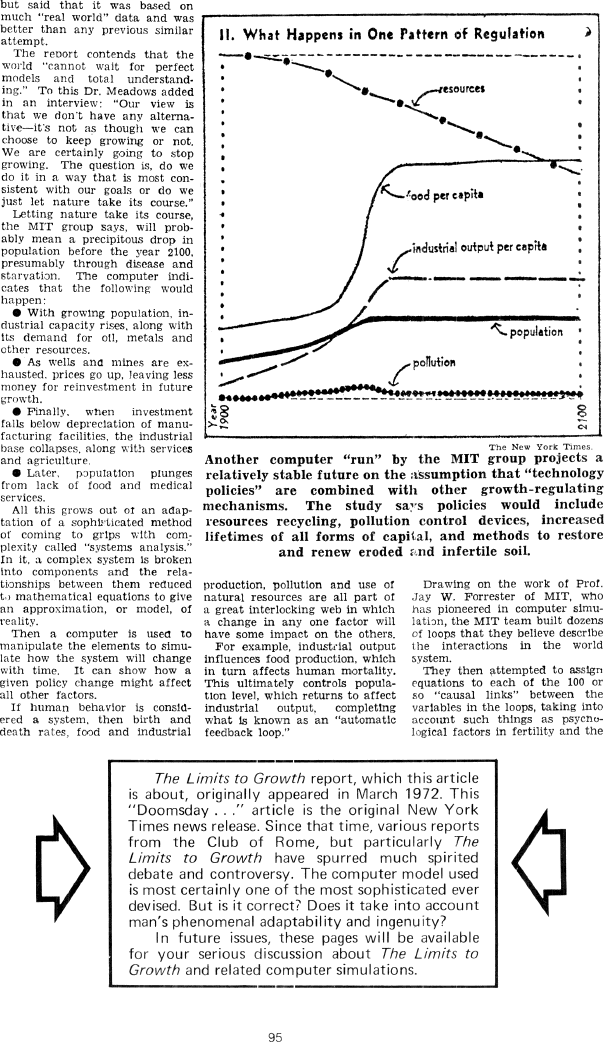The Best of Creative Computing Volume 1 (published 1976)
Doomsday, Says MIT Computer, May Be Just 100 Years Away (population growth, diminishing resources, pollution)

but said that it was based on
much “real world” data and was
better than any previous similar
attempt.
The report contends that the
world "cannot wait for perfect
models and total understanding.”
To this Dr. Meadows added
In an interview: "Our view is
that we don't have any alternative--
it's not as though we can
choose to keep growing or not.
We are certainly going to stop
growing. The question is, do we
do it in a way that is most consistent
with our goals or do we
just let nature take its course."
Letting nature take its course,
the MIT group says, will probably
mean a precipitous drop in
population before the year 2100,
presumably through disease and
starvation. The computer indicates that the following would
happen:
O With growing population,industrial capacity rises, along with
its demand for oil, metals and
other resources.
O As wells and mines are exhausted.
prices go up, leaving less
money for reinvestment in future
growth.
O Finally. when investment
falls below depreciation of manufacturing facilities, the industrial
base collapses, along with services
and agriculture.
O Later, population plunges
from lack of food and medical
services.
All this grows out of an adaptation
of a sophisticated method
of coming to grips with complexity
called “systems analysis."
In it, a complex system is broken
into components and the relationships
between them reduced
to mathematical equations to give
an approximation, or model, of
reality.
Then a computer is used to
manipulate the elements to simulate
how the system will change
with time. It can show how a
given policy change might affect
all other factors.
If human behavior is considered
a system, then birth and
death rates, food and industrial
[image] II. What Happens in One Pattern of Regulation
resources
food per capita
industrial output per capita
population
pollution
Year 1900 2100
The New York Times.
Another computer “run” by the MIT group projects a
relatively stable future on the assumption that “technology
policies” are combined with other growth-regulating
mechanisms. The study says policies would include
resources recycling, pollution control devices, increased
lifetimes of all forms of capital, and methods to restore
and renew eroded and infertile soil.
production, pollution and use of
natural resources are all part of
a great interlocking web in which
a change in any one factor will
have some impact on the others.
For example, industrial output
influences food production, which
in turn affects human mortality.
This ultimately controls population
level, which returns to affect
industrial output, completing
what is known as an "automatic
feedback loop."
Drawing on the work of Prof.
Jay W. Forrester of MIT, who
has pioneered in computer simulation,
the MIT team built dozens
of loops that they believe describe
the interactions in the world
system.
They then attempted to assign
equations to each of the 100 or
so "causal links" between the
variables in the loops, taking into
account such things as psychological
factors in fertility and the
[image] The Limits to Growth report, which this article
is about, originally appeared in March 1972. This
"Doomsday ...” article is the original New York
Times news release. Since that time, various reports
from the Club of Rome, but particularly The
Limits to Growth have spurred much spirited
debate and controversy. The computer model used
is most certainly one of the most sophisticated ever
devised. But is it correct? Does it take into account
man's phenomenal adaptability and ingenuity?
In future issues, these pages will be available
for your serious discussion about The Limits to
Growth and related computer simulations.[image]
95


